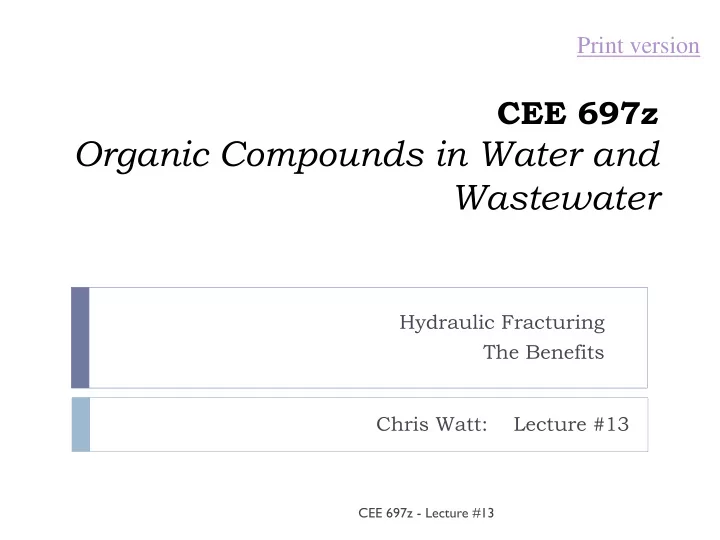

Print version CEE 697z Organic Compounds in Water and Wastewater Hydraulic Fracturing The Benefits Chris Watt: Lecture #13 CEE 697z - Lecture #13
Outline Cons of fracking Economic benefits Oil Shale and Natural Gas Organic Matter in Shale Marcellus Shale Case Study Conclusions CEE 697z - Lecture #13
Not in my backyard Harboring negative feelings Fear Mongering media, dangerous implications Actual harmful environmental impacts Air and water supply pollution Improper disposal of fluids/ withdrawal errors Intensive use of water resources Inconclusive effects Inducing Earthquakes Quicken ‘climate change’ Halliburton Loophole CEE 697z - Lecture #13
“Drill here. Drill now. Pay less” –Newt Gingrich CEE 697z - Lecture #13
Economic incentives Key to unlocking America’s Natural gas supply Shalenanza!!! US Energy Information Administration reports 750 trillion cubic feet of recoverable shale gas and 24 billion barrels of recoverable shale oil have been discovered Boost in local economies In a study of 4 shale plays, 600,000 jobs produced, increased GDP by $76 billion, $18.6 billion generated in tax revenues (IHS 2011) Shale gas provides 25% of our total Natural Gas and is estimated to increase to 46.5% by 2035 (US EIA) CEE 697z - Lecture #13
Importance of Shale Gas CEE 697z - Lecture #13
CEE 697z - Lecture #13
Natural Gas Emits half as much CO2 as coal and 30% less than fuel oil Central to energy plants focused on reduction of greenhouse gases Sources ‘Natural gas’ by-product of producing oil ‘Shale gas’ natural gas produced from shale ‘T own gas’ destructive distillation of coal, uneconomical ‘Biogas’ anaerobic decay of non-fossil organics CEE 697z - Lecture #13
Natural Gas: Combination of hydrocarbon gases ; 70-90% Methane, 1-10% Ethane, trace amounts of Propane, Butane, CO2, O2, N, H2S, Rare gases Formed by decaying Organic Matter Pressure and Heat transformed this into oil, coal, and natural gas Treated/ refined after withdrawn Remove oil and condensates Remove water Separate Natural gas liquids from solids Remove sulfer and CO2 Sour to sweet CEE 697z - Lecture #13
Organic Matter in Shale Oil Shale: fine grained sedimentary rock containing organic matter yielding oil and combustible gas upon destructive distillation Most is insoluble in ordinary organic solvents When oil shale is retorted, organic matter decomposes Organic matter in shale is source of hydrocarbons Higher hydrogen and lower oxygen content than lignite and bituminous coal CEE 697z - Lecture #13
Shale Organic matter origins Remains of algae, spores, pollen, plant cuticle, corky fragments of herbaceous and woody plants, cellular remains of lacustrine, marine, and land plants Major organics in oil shale are telalginite, lamalginite, and bituminite Solid comericially mined hydrocarbons found in oil shale: gilsonite, wurtzlite, grahamite, ozokerite, albertite in form of veins or pods Thermal Maturity of OM =the degree to which OM has been altered by geothermal heating Economic potential Determined by color of OM in borehole Alternatively determined by reflectance of vitrinite CEE 697z - Lecture #13
Evaluating Oil shales Modified Fischer assay (ASTM method D-3904-80) A sample is crushed, placed in mesh, heated to 500 oC for 40 min Distilled vapors run through a cooled condenser, separating oil, gas, and water Quantities reported as weight % of shale oil, water, shale residue, and “gas plus loss” Individual gases (hydrocarbons, H+, CO2) only collectively determined Does not indicate the maximum amount of oil that can be produced in a given oil shale Other retorting methods exist and suggests higher yields but total Energy potential of an oil shale is difficult to quantify CEE 697z - Lecture #13
Impact assessment Little comprehensive analysis to quantify success/failure unproductive dialogue “Environmental Impacts During Marcellus Shale Gas Drilling: Causes, Impacts, and Remedies” Considine et al (2012) From January 2008 - August 2011 recorded 2,988 notices of violoation (NOVs) from PA DEP 1,844 (62%) for administrative or preventative reasons 1,144 (38%) for environmental violations. Note that 845 unique environmental events associated with these NOVs 25 of these events were considered Major, all but 6 have been remedied completely EACH of these events would be avoided under New York SGEIS guidelines CEE 697z - Lecture #13
CEE 697z - Lecture #13
CEE 697z - Lecture #13
CEE 697z - Lecture #13
NY SGEIS New York Supplemental Generic Environmental Impact Statement Extremely Comprehensive to regulate oil and gas industry Preventative measures and regulations on Blowouts & Venting, Spills on Land, Gas Migration and Casing & Cementing, Site Restoration, Water Contamination, CEE 697z - Lecture #13
CSSD Center for Sustainable Shale gas Development Air quality impacts- minimizing leaks of methane Promotes BMPs Objections 1. Joining forces with the enemy 2. Making use of Natural Gas extends our dependence on fossil fuels CEE 697z - Lecture #13
Marcellus Shale Findings 1. Only two documented cases of polluted subsurface water supply from stray gas 2. Four serious well blowouts (0.11% probability) 3. Environmental damages were repaired in all but six 4. Majority of events due to operational error, negligence, or failure to follow proper drilling procedure CEE 697z - Lecture #13
Conclusions We primarily rely on fossil fuels, not alternatives Over 44 months, there was a 0.7% chance of a major environmental event Decline of NOVs in conjunction with state regulators In particular, the percent of wells resulting in a major environmental event declined significantly Managing unconventional gas development is possible Each of the 25 major events would have been avoided or mitigated under New York state regulation CEE 697z - Lecture #13
"This study presents a compelling case that state oversight of oil and gas regulation has been effective. While prior research has anecdotally reviewed state regulations, now we have comprehensive data that demonstrates, without ambiguity, that state regulation coupled with improvements in industry practices results in a low risk of an environmental event occurring in shale development, and the risks continue to diminish year after year.“ –Timothy Considine CEE 697z - Lecture #13
To next lecture CEE 697z - Lecture #13
Recommend
More recommend